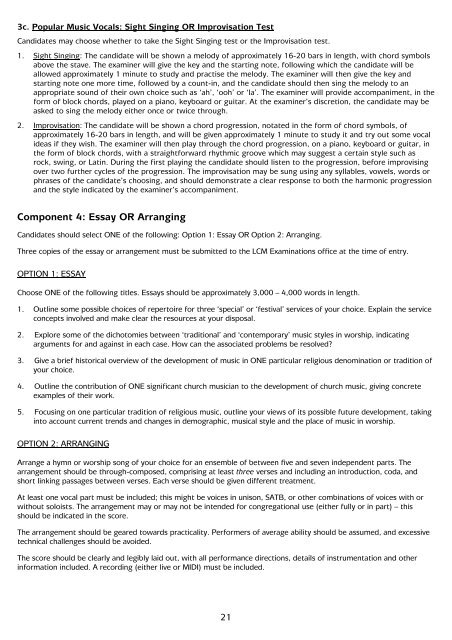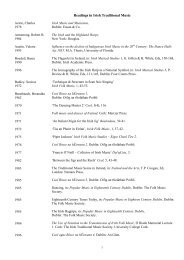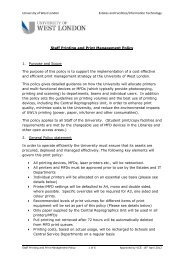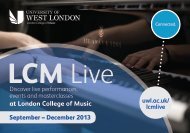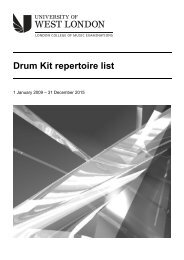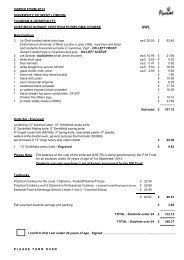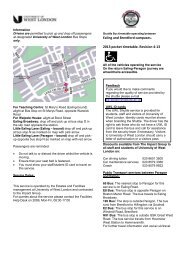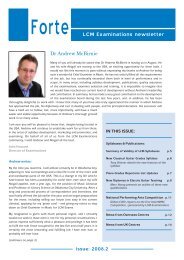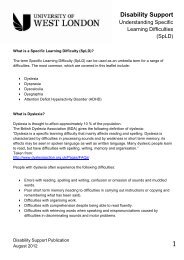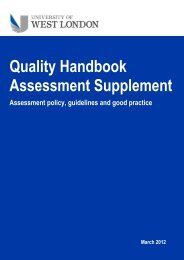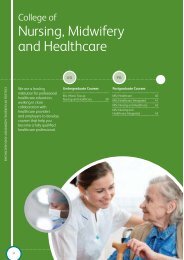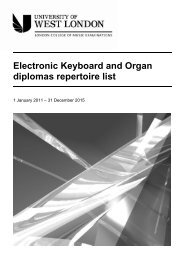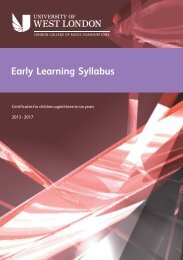LCM Exams - Church Music Diplomas - University of West London
LCM Exams - Church Music Diplomas - University of West London
LCM Exams - Church Music Diplomas - University of West London
- No tags were found...
You also want an ePaper? Increase the reach of your titles
YUMPU automatically turns print PDFs into web optimized ePapers that Google loves.
3c. Popular <strong>Music</strong> Vocals: Sight Singing OR Improvisation TestCandidates may choose whether to take the Sight Singing test or the Improvisation test.1. Sight Singing: The candidate will be shown a melody <strong>of</strong> approximately 16-20 bars in length, with chord symbolsabove the stave. The examiner will give the key and the starting note, following which the candidate will beallowed approximately 1 minute to study and practise the melody. The examiner will then give the key andstarting note one more time, followed by a count-in, and the candidate should then sing the melody to anappropriate sound <strong>of</strong> their own choice such as ‘ah’, ‘ooh’ or ‘la’. The examiner will provide accompaniment, in theform <strong>of</strong> block chords, played on a piano, keyboard or guitar. At the examiner’s discretion, the candidate may beasked to sing the melody either once or twice through.2. Improvisation: The candidate will be shown a chord progression, notated in the form <strong>of</strong> chord symbols, <strong>of</strong>approximately 16-20 bars in length, and will be given approximately 1 minute to study it and try out some vocalideas if they wish. The examiner will then play through the chord progression, on a piano, keyboard or guitar, inthe form <strong>of</strong> block chords, with a straightforward rhythmic groove which may suggest a certain style such asrock, swing, or Latin. During the first playing the candidate should listen to the progression, before improvisingover two further cycles <strong>of</strong> the progression. The improvisation may be sung using any syllables, vowels, words orphrases <strong>of</strong> the candidate’s choosing, and should demonstrate a clear response to both the harmonic progressionand the style indicated by the examiner’s accompaniment.Component 4: Essay OR ArrangingCandidates should select ONE <strong>of</strong> the following: Option 1: Essay OR Option 2: Arranging.Three copies <strong>of</strong> the essay or arrangement must be submitted to the <strong>LCM</strong> Examinations <strong>of</strong>fice at the time <strong>of</strong> entry.OPTION 1: ESSAYChoose ONE <strong>of</strong> the following titles. Essays should be approximately 3,000 – 4,000 words in length.1. Outline some possible choices <strong>of</strong> repertoire for three ‘special’ or ‘festival’ services <strong>of</strong> your choice. Explain the serviceconcepts involved and make clear the resources at your disposal.2. Explore some <strong>of</strong> the dichotomies between ‘traditional’ and ‘contemporary’ music styles in worship, indicatingarguments for and against in each case. How can the associated problems be resolved?3. Give a brief historical overview <strong>of</strong> the development <strong>of</strong> music in ONE particular religious denomination or tradition <strong>of</strong>your choice.4. Outline the contribution <strong>of</strong> ONE significant church musician to the development <strong>of</strong> church music, giving concreteexamples <strong>of</strong> their work.5. Focusing on one particular tradition <strong>of</strong> religious music, outline your views <strong>of</strong> its possible future development, takinginto account current trends and changes in demographic, musical style and the place <strong>of</strong> music in worship.OPTION 2: ARRANGINGArrange a hymn or worship song <strong>of</strong> your choice for an ensemble <strong>of</strong> between five and seven independent parts. Thearrangement should be through-composed, comprising at least three verses and including an introduction, coda, andshort linking passages between verses. Each verse should be given different treatment.At least one vocal part must be included; this might be voices in unison, SATB, or other combinations <strong>of</strong> voices with orwithout soloists. The arrangement may or may not be intended for congregational use (either fully or in part) – thisshould be indicated in the score.The arrangement should be geared towards practicality. Performers <strong>of</strong> average ability should be assumed, and excessivetechnical challenges should be avoided.The score should be clearly and legibly laid out, with all performance directions, details <strong>of</strong> instrumentation and otherinformation included. A recording (either live or MIDI) must be included.21


